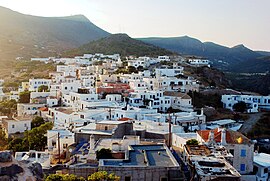Kythira
Κύθηρα | |
|---|---|
 View of Cythera's capital (Chora) from the Castle | |
| Coordinates: 36°15′27″N 22°59′51″E / 36.25750°N 22.99750°E | |
| Country | Greece |
| Administrative region | Attica |
| Regional unit | Islands |
| Government | |
| • Mayor | Efstratios Charchalakis[1] (since 2019) |
| Area | |
| • Municipality | 300.0 km2 (115.8 sq mi) |
| • Municipal unit | 279.6 km2 (108.0 sq mi) |
| Elevation | 506 m (1,660 ft) |
| Population (2021)[2] | |
| • Municipality | 3,644 |
| • Density | 12/km2 (31/sq mi) |
| • Municipal unit | 3,605 |
| • Municipal unit density | 13/km2 (33/sq mi) |
| • Community | 550 |
| Time zone | UTC+2 (EET) |
| • Summer (DST) | UTC+3 (EEST) |
| Postal code | 801 00 |
| Area code(s) | 2736 |
| Vehicle registration | Z |
| Website | www.kythira.gr |
Kythira (/kɪˈθɪərə, ˈkɪθɪrə/ kih-THEER-ə, KITH-irr-ə; Greek: Κύθηρα [ˈciθira]), also transliterated as Cythera, Kythera and Kithira,[a] is an island in Greece lying opposite the south-eastern tip of the Peloponnese peninsula. It is traditionally listed as one of the seven main Ionian Islands, although it is distant from the main group. Administratively, it belongs to the Islands regional unit, which is part of the Attica region, despite its distance from the Saronic Islands, around which the rest of Attica is centered. As a municipality, it includes the island of Antikythera to the south.
The island is strategically located between the Greek mainland and Crete, and from ancient times until the mid-19th century was a crossroads of merchants, sailors, and conquerors. As such, it has had a long and varied history and has been influenced by many civilizations and cultures. This is reflected in its architecture (a blend of traditional, Aegean and Venetian elements), as well as the traditions and customs, influenced by centuries of coexistence of the Greek, and Venetian cultures.
- ^ Municipality of Kythira, Municipal elections – October 2023, Ministry of Interior
- ^ "Αποτελέσματα Απογραφής Πληθυσμού - Κατοικιών 2021, Μόνιμος Πληθυσμός κατά οικισμό" [Results of the 2021 Population - Housing Census, Permanent population by settlement] (in Greek). Hellenic Statistical Authority. 29 March 2024.
Cite error: There are <ref group=lower-alpha> tags or {{efn}} templates on this page, but the references will not show without a {{reflist|group=lower-alpha}} template or {{notelist}} template (see the help page).

